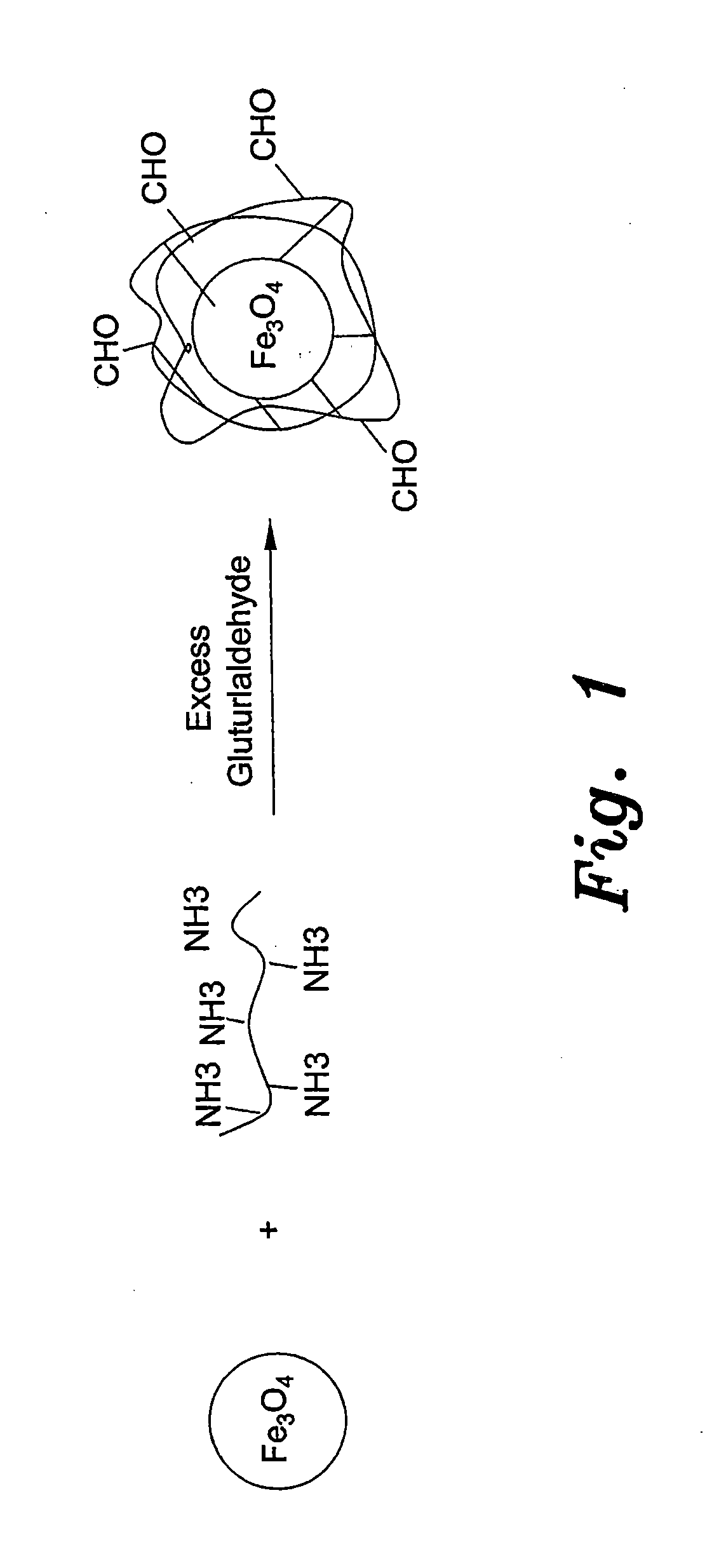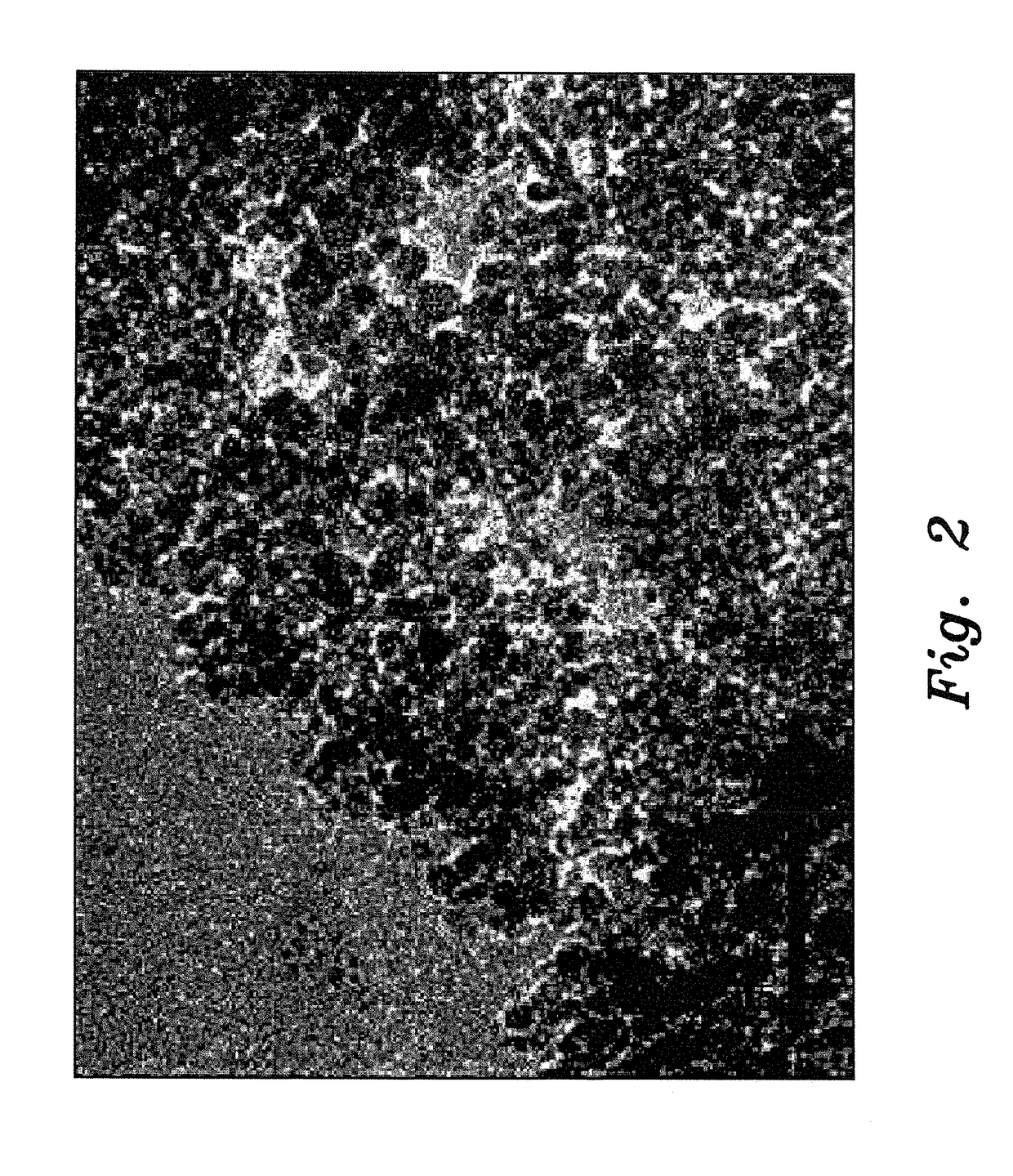Method for preparing chitosan-coated magnetic nanoparticles for protein immobilization
a technology of magnetic nanoparticles and protein immobilization, which is applied in the field of magnetic nanoparticles for protein immobilization, can solve the problems of limiting the adoption of this technology on a commercial scale, high cost and instability, and edc use rendering the process costly
- Summary
- Abstract
- Description
- Claims
- Application Information
AI Technical Summary
Benefits of technology
Problems solved by technology
Method used
Image
Examples
example 1
Preparation of Magnetic Fe3O4 Nanoparticles
[0023]In a container, 2.7 g ferric chloride (hexahydrate) and 3.9 g ferrous chloride (tetrahydrate) (2:1 molar ratio) were dissolved in water to form an iron-containing solution and heated to 80° C. Then about 50 ml solution of NaOH (30%) was added to the solution to adjust the pH to 8.5-10 and the reaction was maintained for about 2 hours to obtain magnetic nanoparticles of Fe3O4. Finally, the magnetic nanoparticles were washed several times with deionized water and dried at 80° C. in an oven.
example 2
Coating of Magnetic Fe3O4 Nanoparticles
[0024]Low-molecular-weight chitosan (≧85%) deacetylation was prepared as described previously in the prior art (Yateendra et al., 2012). Chitosan-coated magnetic nanoparticles were obtained by dispersing 0.5 g of magnetic nanoparticles in 30 ml 1% chitosan solution and 1% acetic acid followed by sonication for 15 minutes. The dispersion was added to 70 ml paraffin oil and 0.5 g of SPAN® 20 (sorbitan monododecanoate), which was used as surfactant. A water-in-oil dispersion was obtained by vigorous ultrasonic stirring for 30 min. Then, 5 ml of 50% glutaraldehyde solution (CH2(CH2CHO)2) was added for 3 hours at room temperature under magnetic stirring. The solution was then maintained overnight at 4° C. Magnetic nanobeads, were then washed several times by methanol, acetone and water to remove paraffin oil residues, then dried in an oven at 80° C. for 12 h. As shown in FIG. 2, the average diameter of the resulting beads, determined by electron mic...
example 3
Protein Coupling with Chitosan Coated Magnetic Nano Beads
[0025]About 100 mg of chitosan coated magnetic nanobeads was dispersed in 9 ml of PBS buffer (pH 7.0) and then mixed with 1 ml BSA (bovine serum albumin) at different concentrations (i.e., 1, 5, 10, 15, 20, 30 and 50 mg) dissolved in PBS buffer. The mixture was maintained for 16 hours at 4° C. under stirring condition (120 rpm). Then the magnetic particles were collected using a strong magnet. The supernatant was used to measure the protein concentration using Bradford method and the results were compared to the BSA standard curve. Then, the unbounded protein was measured using the Bradford method as shown in Table 1 below.
TABLE 1Bound and Unbounded Protein as measured using Bradford methodTotal protein (mg)(Bradford)UnboundBound10150510281531220812301713503614
[0026]The results indicated that an amount of 15 mg of protein for 100 mg of beads was the best concentration for the highest saturation.
PUM
| Property | Measurement | Unit |
|---|---|---|
| diameter | aaaaa | aaaaa |
| pH | aaaaa | aaaaa |
| magnetic | aaaaa | aaaaa |
Abstract
Description
Claims
Application Information
 Login to View More
Login to View More - R&D
- Intellectual Property
- Life Sciences
- Materials
- Tech Scout
- Unparalleled Data Quality
- Higher Quality Content
- 60% Fewer Hallucinations
Browse by: Latest US Patents, China's latest patents, Technical Efficacy Thesaurus, Application Domain, Technology Topic, Popular Technical Reports.
© 2025 PatSnap. All rights reserved.Legal|Privacy policy|Modern Slavery Act Transparency Statement|Sitemap|About US| Contact US: help@patsnap.com



